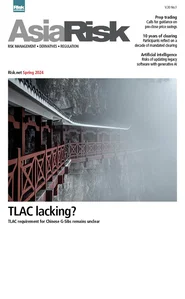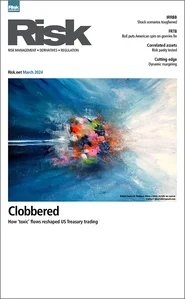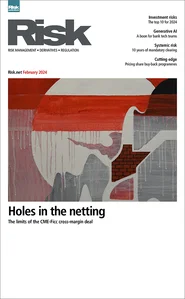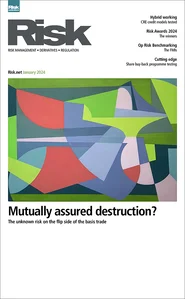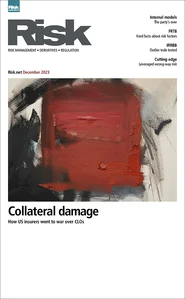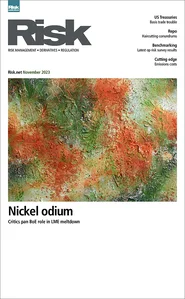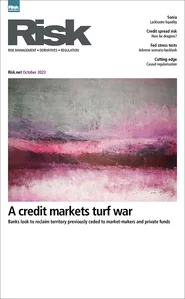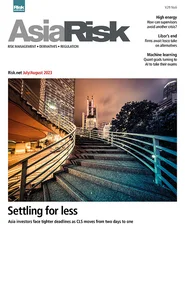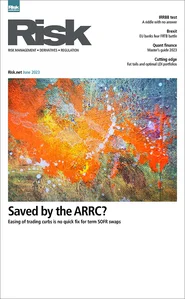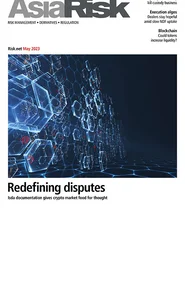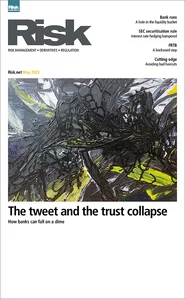Risk magazine - Jun 2017
Articles from our June issue include: the changing role of the quant; the new rules that threaten Formosa hedging; settlement risk and how to close OTC margin gaps; plus technical articles on portfolio management and option pricing
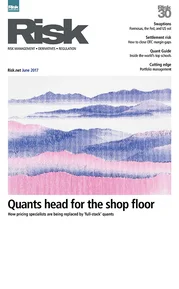
Articles in this issue
Analyse this: the future for quants
Quant headcount is up on pre-crisis levels, but jobs in front-office functions have been decimated
Modal patterns in market data stump Morgan Stanley quants
New research suggests algo traders are changing the market microstructure
ECB and Esma would call shots on euro clearing
Proposals give central bank and regulator the power to bar biggest third-country CCPs
FRTB threatens popular hedge fund strategies
Brevan exec says market risk capital rules could force buy side out of certain trades
FRTB standardised approach threatens commodity hedging
Basel language would force unnatural treatment of offsetting positions
Basel group said to weigh changes to key FRTB test
EC and EBA officials criticise low pass rates for P&L attribution test
Spectre of mass swap unwinds looms ahead of VM deadline
Dealers warn of market disruption if trades lacking new CSAs are terminated before September 1
LCH set to launch repo client clearing service
Project will allow buy-side firms to access CCP through sponsor banks in coming months
EU regulator dampens SA-CCR reform hopes
Isda AGM: EBA acknowledges approach’s shortcomings, but warns Basel is not reconsidering
Swaps market’s health seen as resting on sickly repo
Isda AGM: Panellists warn repo market is risky way to fund swaps margin
Basel opts for aggregate bank capital output floor
Banks will have more flexibility on use of internal models, but calibration still undecided
People: HSBC’s Karl joins Isda
OCC names new chief information officer; Nex nabs JP Morgan’s Americas head of derivatives clearing
Quants head for the shop floor
Demand for technical skills is growing, but roles have changed – and some schools are not keeping up
Formosas, the Fed, and the billion-dollar Bermudan trade
Rates options desks on alert as decline in Formosa bond issuance could hit profits and raise US volatility
Time trial: the big risks that lurk in OTC margin gaps
Banks take aim at margin and trade-flow lag that can cause 95% of counterparty risk
Volatility of IFRS 9 loss estimates alarms lenders
Accounting model outputs wildly out of sync with those used to calculate regulatory capital requirements
Banks diving into credit data pools as official support grows
European regulators embrace external data for internal modelling of credit risk capital
Netting no problem for blockchain, tech firms tell regulators
Firms say DLT can sit with current market practice, but instantaneous settlement 'not desirable'
Growth in factor investing renews crowding fears
Single-factor ETFs could pose threat to quantitative equity market neutral strategies
Banks less stressed about CCAR
Fed’s 2017 stress test assumes 10% peak unemployment and sharp drop in commercial property prices
Banks split on Mifid II pre-trade compliance
Esma promises guidance, but some say ‘firm, executable’ quotes are impossible
Fears of fragmentation over Basel shadow banking rules
Step-in risk guidelines could be taken more seriously in the EU than in the US
Power struggle: EU battles for supervisory convergence
European Commission’s review of the three supervisory authorities fraught with difficulties
Emir review could push securitisations into the dark
Subjecting deals to margin requirements would be a further blow to STS securitisation concept
Seeds of destruction? Funds grapple with index effect
Rapid growth fuels anxiety over passive sector’s vulnerability to frontrunning
Wolfe aims to shake up research with AI push
Mifid II and the rise in computing power is helping boutique shops challenge the banks
Andrew Lo’s theory to beat a theory
Author of Adaptive Markets tells Risk.net what his ideas mean for investors and regulators
Lessons from the Mortician: volatility modulation
Paul Tudor Jones II, Santhanam Nagarajan and Dario Villani show how to use volatility modulation
Too little, too late: Esma data won’t fix energy firms’ Mifid woes
Data confusion and unworkable exemption timeframe risk commodity market disruption
Size-discovery protocols are not on the efficient frontier
Practice improves allocations but more can be done, says Darrell Duffie
Monthly credit data review: new-tech scepticism
David Carruthers of Credit Benchmark looks at the most recent trends in bank-sourced credit data
Monthly swaps data review: ADV for OTC derivatives
Daily volumes are a pillar of the futures market, and can now be found for US swaps
Managing FX risk: How to prepare for the unpredictable
Sponsored feature: HSBC
Updated: Quant Finance Master’s Guide 2017
Welcome to Risk.net’s guide to the world’s leading quantitative finance master’s programmes
The quant factory: not muppets, but not perfect
Universities offering quant master’s programmes must adapt to stay relevant, writes UBS’s Gordon Lee
Quant Guide 2017: University of California, Berkeley
Haas School of Business, Berkeley, USA
Quant Guide 2017: Carnegie Mellon University
Tepper School of Business, Pittsburgh, USA
Quant Guide 2017: University of Chicago
Chicago, USA
Quant Guide 2017: Columbia University
New York City, USA
Quant Guide 2017: Massachusetts Institute of Technology
Sloan School of Management, Cambridge, USA
Quant Guide 2017: Baruch College, City University of New York
New York City, USA
Quant Guide 2017: NYU Tandon School of Engineering
New York City, USA
Quant Guide 2017: Princeton University
Bendheim Center for Finance, Princeton, USA
Quant Guide 2017: Rutgers University
Piscataway, USA
Quant Guide 2017: Stony Brook University
Brookhaven, USA
Quant Guide 2017: University of Washington
Seattle, USA
Quant Guide 2017: University of Toronto
Toronto, Canada
Quant Guide 2017: University of Waterloo
Waterloo, Canada
Quant Guide 2017: IMPA
Rio de Janeiro, Brazil
Quant Guide 2017: City, University of London
Bayes Business School (formerly Cass Business School), London, UK
Quant Guide 2017: Imperial College London
London, UK
Quant Guide 2017: King’s College London
London, UK
Quant Guide 2017: LSE
London, UK
Quant Guide 2017: University of Oxford
Oxford, UK
Quant Guide 2017: University of Warwick
Warwick Business School, Coventry, UK
Quant Guide 2017: University of York
York, UK
Quant Guide 2017: University of Bologna
Bologna, Italy
Quant Guide 2017: Bocconi University
Milan, Italy
Quant Guide 2017: University of Florence
Florence, Italy
Quant Guide 2017: University of Turin
Collegio Carlo Alberto, Moncalieri, Italy
Quant Guide 2017: EISTI
Cergy-Pontoise, France
Quant Guide 2017: Paris Diderot University
Paris, France
Quant Guide 2017: Pierre and Marie Curie University
Paris, France
Quant Guide 2017: University of Amsterdam
Amsterdam, Netherlands
Quant Guide 2017: Erasmus University Rotterdam
Rotterdam, Netherlands
Quant Guide 2017: EPFL
Lausanne, Switzerland
Quant Guide 2017: ETH Zurich/University of Zurich
Zurich, Switzerland
Quant Guide 2017: University of Leuven
Leuven, Belgium
Quant Guide 2017: University of Copenhagen
Copenhagen, Denmark
Quant Guide 2017: Technical University of Munich
Munich, Germany
Quant Guide 2017: University of Sydney
Sydney, Australia
Quant Guide 2017: Maharishi University of Information Technology
School of Financial Engineering, Noida, India
Quant Guide 2017: Hong Kong University of Science and Technology
Hong Kong, China
Stress hedging in portfolio construction
Bilgili, Ferconi and Ulitsky propose a constrained portfolio optimisation approach incorporating stress scenarios
Model calibration with neural networks
Andres Hernandez presents a neural network approach to speed up model calibration
Bounding Bermudans
Thomas Roos derives model-independent bounds for amortising and accreting Bermudan swaptions
Corlytics: data reveals least-predictable regulators
Regtech start-up says NY watchdog’s record has prompted banks to retreat
















































































